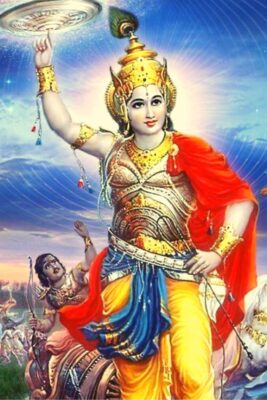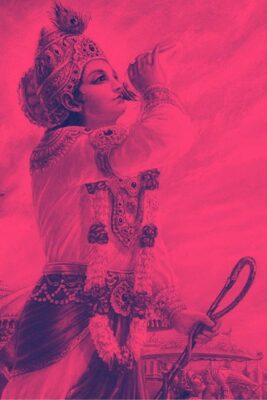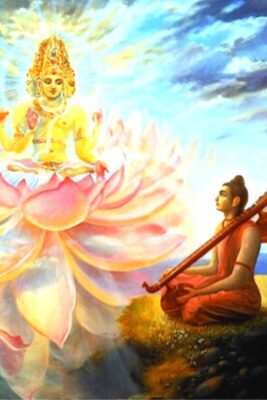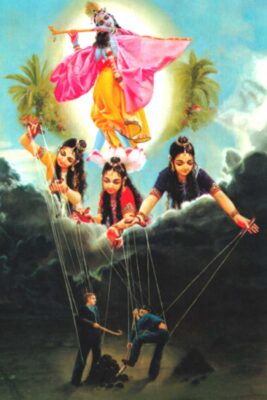Gita
The Shrimad Bhagavad Gita, often referred to as the Gita, is a 700-verse Hindu scripture that is part of the epic Mahabharata, dated to the second half of the first millennium BCE and is typical of the Hindu synthesis. It is considered to be one of the holy scriptures for Hinduism.
Gita Lessons
Battle of Kuruksetra
The Bhagavad Gita, or the song of God, was revealed by Lord Shree Krishna to Arjun on the threshold of the epic war of Mahabharata. A decisive battle between two sets of cousins, the Kauravas and the Pandavas, was just about to commence on the battlefield of Kurukshetra. A detailed account of the reasons that led to such a colossal war; is given under Introduction-The Setting of the Bhagavad Gita.
भगवद्गीता का उपदेश एक ही वंश के दो परिवारों के चचेरे भाइयों कौरव और पाण्डवों के मध्य हुए महाभारत के युद्ध की रणभूमि पर दिया गया। इस पुस्तक के परिचय से संबंधित प्रारम्भिक पृष्ठों में उल्लिखित ‘गीता का परिवेश’ खण्ड में उन घटनाओं का विस्तृत रूप से वर्णन किया गया है जिनके कारण यह महायुद्ध हुआ।
View BookGita Summarized
In this chapter, Arjun reiterates to Shree Krishna that he is unable to cope with his current situation, where he has to kill his elders and teachers. He refuses to take part in such a battle and requests Shree Krishna to be his spiritual teacher and guide him on the proper path of action. Then the Supreme Lord starts imparting divine knowledge to Arjun. He begins with the immortal-nature of the soul, which is eternal and imperishable. Death only destroys the physical body, but the soul continues its journey.
इस अध्याय में अर्जुन अपने सम्मुख उत्पन्न स्थिति का सामना करने में स्पष्ट रूप से अपनी असमर्थता को दोहराता है और युद्ध करने के अपने कर्तव्य का पालन करने से मना कर देता है। तत्पश्चात वह औपचारिक रूप से श्रीकृष्ण को अपना आध्यात्मिक गुरु बनाने और जिस स्थिति में वह स्वयं को पाता है, उसका सामना करने के लिए उचित मार्गदर्शन प्रदान करने की प्रार्थना करता है। परम प्रभु उससे कहते हैं कि आत्मा, जो शरीर के नष्ट होने पर भी नहीं मरती, के अमरत्व की शिक्षा देकर दिव्य ज्ञान प्रदान करते हैं। आत्मा एक जन्म से दूसरे जन्म में उसी प्रकार से शरीर परिवर्तित करती है जिस प्रकार से मनुष्य पुराने वस्त्र त्याग कर नये वस्त्र धारण करता है। इसके पश्चात श्रीकृष्ण सामाजिक दायित्त्वों के विषय की ओर आगे बढ़ते हैं।
View BookKarma Yoga
Shree Krishna expounds on karm yog or the yog of action in this chapter. He explains to Arjun that nobody can remain without action, even for a moment. Bound by their inherent modes of nature, all beings are always engaged in some work. Superior are those who practice karm yog and continue to work diligently to fulfill their responsibilities externally, but internally they are unattached to them. However, the hypocrites display external renunciation but internally dwell upon the objects of their senses.
इस अध्याय में श्रीकृष्ण यह समझाते हैं कि सभी जीव अपनी स्वाभाविक प्रकृति के गुणों के कारण कार्य करने के लिए बाध्य होते हैं और कोई भी प्राणी एक क्षण के लिए भी अकर्मा नहीं रह सकता। वे जो गेरुए वस्त्र धारण कर बाह्य रूप से वैराग्य प्रदर्शित करते हैं लेकिन आंतरिक रूप से इन्द्रिय विषयों के भोगों के प्रति आसक्ति रखते हैं, वे ढोंगी हैं। जो कर्मयोग का अनुपालन करते हुए बाह्य रूप से निरन्तर कर्म करते रहते हैं लेकिन उनमें आसक्त नहीं होते, वे उनसे श्रेष्ठ हैं।
View BookTranscendental Knowledge
To strengthen Arjun’s faith in the knowledge He is imparting, Shree Krishna reveals its pristine origin in this chapter. He says, “Arjun, as you are my devotee and a dear friend, I am revealing this supreme science of yog to you. It is the same eternal science that I taught to the Sun God at the beginning of time. And in a continuous tradition, the same knowledge; was passed to the saintly kings.”
चौथे अध्याय में श्रीकृष्ण अर्जुन को दिए जा रहे दिव्य ज्ञान के आदिकालीन उद्गम को प्रकट करते हुए उसमें उसके विश्वास को पुष्ट करते हैं। वे बताते हैं कि यह वही शाश्वत ज्ञान है जिसका उपदेश उन्होंने आरम्भ में सर्वप्रथम सूर्यदेव को दिया था और फिर परम्परागत पद्धति से यह ज्ञान निरन्तर राजर्षियों तक पहँचा। अब वे अर्जुन, जो उनका प्रिय मित्र और परमभक्त है, के सम्मुख इस दिव्य ज्ञान को प्रकट कर रहे हैं।
View BookKarm Sanyās Yog
In this chapter, Shree Krishna compares karm sanyās yog (the path of renunciation of actions) with karm yog (the path of work in devotion). He says: we can choose either of the two paths, as both lead to the same destination. However, he explains that the renunciation of actions is rather challenging and can only be performed flawlessly by those whose minds are adequately pure. Purification of the mind can be achieved only by working in devotion. Therefore, karm yog is a more appropriate path for the majority of humankind.
इस अध्याय में कर्म संन्यास के मार्ग की तुलना कर्मयोग के मार्ग के साथ की गयी है। श्रीकृष्ण बताते हैं कि दोनों मार्ग एक ही लक्ष्य की ओर ले जाते हैं और हम इनमें से किसी एक का चयन कर सकते हैं। लेकिन कर्म का त्याग तब तक पूर्णरूप से नहीं किया जा सकता। जब तक मन पूर्णतः शुद्ध न हो जाए और मन की शुद्धि भक्ति के साथ कर्म करने से प्राप्त होती है। इसलिए कर्मयोग बहुसंख्यक लोगों के लिए उपयुक्त विकल्प है।
View BookDhyana Yoga
Shree Krishna continues the comparative evaluation between karm yog (the practice of spirituality while performing worldly duties) and karm sanyas (the practice of spirituality in a renounced state) in this chapter. He reiterates that karm yog is a more practicable path than karm sanyas. When work is done with devotion, it purifies the mind and enhances the spiritual realization. The mind then becomes tranquil, and meditation becomes the primary means of elevation.
श्रीकृष्ण कर्मयोग और कर्म संन्यास के तुलनात्मक मूल्यांकन के अनुक्रम को पांचवें अध्याय से इस छठे अध्याय में भी जारी रखते हैं और पहले वाले मार्ग के अनुसरण की संस्तुति करते हैं। जब हम समर्पण के साथ कार्य करते हैं तब इससे हमारा मन शुद्ध हो जाता है और हमारी आध्यात्मिक अनुभूति गहन हो जाती है। फिर जब मन शांत हो जाता है तब साधना उत्थान का मुख्य साधन बन जाती है। ध्यान द्वारा योगी मन को वश में करने का प्रयास करते हैं क्योंकि अप्रशिक्षित मन हमारा बुरा शत्रु है और प्रशिक्षित मन हमारा प्रिय मित्र है।
View BookKnowledge of Absolute
This chapter begins with Shree Krishna describing the material and spiritual dimensions of God’s energies. He explains that similar to beads strung on a single thread, all these energies have originated from Him and rest in Him. The entire creation begins and dissolves into Him. Although it is very difficult to overcome His material energy Maya, those who surrender to Him can easily cross over it by His grace.
यह अध्याय भगवान की शक्तियों के भौतिक और आध्यात्मिक आयामों के वर्णन के साथ आरम्भ होता है। श्रीकृष्ण व्यक्त करते हैं कि ये सब उन्हीं से प्रकट होते हैं और धागे में गुंथे मोतियों की भाँति उनमें स्थित रहते हैं। वे समूची सृष्टि के स्रोत हैं और ये सब उन्हीं में पुनः विलीन हो जाते हैं। उनकी प्राकृत शक्तिमाया पर विजय प्राप्त करना अत्यंत दुष्कर है लेकिन वे जो भगवान के शरणागत हो जाते हैं वे उनकी कृपा प्राप्त करते हैं और इस पर सरलता से विजय पा लेते हैं।
View BookAttaining The Supreme
In this chapter, Shree Krishna briefly describes several significant concepts and terms that the Upanishads expound in detail. He also explains what decides the destination of the soul after death. He says that if we remember God at the time of death, we can definitely attain Him. Therefore, alongside doing our daily works, we must always practice thinking of God.
यह अध्याय संक्षेप में कुछ महत्वपूर्ण शब्दों और अवधारणाओं का वर्णन करता है जिनका उपनिषदों में विस्तार से उल्लेख किया गया है। इसमें यह वर्णन भी किया गया है कि मृत्यु के पश्चात आत्मा के गन्तव्य का निर्धारण किस प्रकार से होता है।
View BookConfidential Knowledge
In the two previous chapters, the Supreme Lord Shree Krishna declared that among all, bhakti is the highest, yet the simplest path of attaining Yog, or union with the Supreme. In this chapter, He reveals His supreme glories that inspire reverence, devotion, and awe. Although Shree Krishna stands in front of Arjun in His personal form, it should not be mistaken to possess human personality.
सातवें और आठवें अध्याय में श्रीकृष्ण ने भक्ति को योग प्राप्त करने का सरल साधन और योग की उत्तम पद्धति बताया था। नौवें अध्याय में उन्होंने अपनी परम महिमा का व्याख्यान किया है जिससे विस्मय, श्रद्धा और भक्ति उत्पन्न होती है। वे यह बोध कराते हैं कि यद्यपि वे अर्जुन के सम्मुख साकार रूप में खड़े हैं किन्तु उन्हें मनुष्य के रूप में मानने की दुर्भावना धारण नहीं करनी चाहिए। वे स्पष्ट कहते हैं कि वे समस्त प्राकृतिक शक्तियों के अध्यक्ष हैं और सृष्टि सृजन के आरम्भ में अनगिनत जीवों के जीवन रूपों को उत्पन्न करते हैं और प्रलय के समय वापस उन्हें अपने में विलीन कर लेते हैं तथा सृष्टि के अगले चक्र में उन्हें पुनः प्रकट करते हैं। जिस प्रकार से शक्तिशाली वायु सभी स्थानों पर प्रवाहित होती है और सदैव आकाश में स्थित रहती है। उसी प्रकार से सभी जीव भगवान में निवास करते हैं फिर भी वे अपनी योगमाया शक्ति द्वारा तटस्थ पर्यवेक्षक बने रहकर इन सभी गतिविधियों से विलग और विरक्त रहते हैं।
View BookOpulence of the Absolute
The previous chapter revealed the science of bhakti or loving devotion of God. In this chapter, Shree Krishna desires to increase Arjun’s bhakti by describing His infinite glories and opulence. The verses are not only pleasing to read but also enchanting to hear. He helps Arjun to meditate on God by reflecting upon His magnificence.
इस अध्याय में श्रीकृष्ण ने अपनी भव्य और दीप्तिमान महिमा का वर्णन किया है जिससे अर्जुन को भगवान में अपना ध्यान केन्द्रित करने में सहायता मिल सके। नौवें अध्याय में श्रीकृष्ण ने भक्ति योग या प्रेममयी भक्ति की व्याख्या करते हुए अपने कुछ वैभवों का वर्णन किया था। यहाँ इस अध्याय में वे आगे अर्जुन के भीतर श्रद्धा भक्ति को बढ़ाने के प्रयोजनार्थ अपनी अनन्त महिमा का पुनः वर्णन करते हैं। इन श्लोकों को पढ़ने से आनन्द की अनुभूति होती है और इनका श्रवण करने से मन प्रफुल्लित हो जाता है।
View BookThe Universal Form
In this chapter, he requests the Lord to show him His viśhwarūp, or the infinite cosmic form. Shree Krishna grants Arjun divine vision to see His infinite-form that comprises all the universes. Arjun sees the entire creation in the body of the God of gods with unlimited arms, faces, and stomachs. It has no beginning or end and extends immeasurably in all directions. His radiance is similar to a thousand suns blazing together in the sky.
इस अध्याय में अर्जुन श्रीकृष्ण से प्रार्थना करता है कि वे उसे अपने विश्व रूप या सभी ब्रह्माण्डों में व्याप्त अपने अनंत ब्रह्माण्डीय विराट रूप का दर्शन कराएँ। तब श्रीकृष्ण उस पर कृपा करते हुए उसे अपनी दिव्य दृष्टि प्रदान करते हैं जिसे प्राप्त कर अर्जुन देवों के देव श्रीकृष्ण के शरीर में सम्पूर्ण सृष्टि का अवलोकन करता है। फिर वह भगवान के अद्भुत अनंत स्वरूप में अनगनित मुख, आँखें, भुजाएँ, उदर देखता है। उनके विराट रूप का कोई आदि और अन्त नहीं है और वह प्रत्येक दिशा में अपरिमित रूप से बढ़ रहा है।
View BookDevotional Service
This chapter begins with Arjun asking Shree Krishna about the two types of yogis and among them whom does He consider perfect. Those who worship the formless Brahman or those who are devoted to the personal-form of God. Shree Krishna declares that devotees can attain Him by both paths. However, He considers those who worship His personal-form as the best yogis. In this small chapter of 20 verses, Shree Krishna emphasizes that the path of devotion is the highest among all types of spiritual practices.
इस छोटे अध्याय में आध्यात्मिक साधनाओं के अन्य मार्गों की अपेक्षा भक्ति मार्ग की सर्वोत्कृष्टता के महत्त्व पर प्रकाश डाला गया है। इसका प्रारम्भ अर्जुन द्वारा श्रीकृष्ण से पूछे गए इस प्रश्न से होता है कि वह योग में किन्हें पूर्ण माने, क्या जो भगवान की साकार रूप में भक्ति करते हैं या वे जो निराकार ब्रह्म की उपासना करते हैं? इसका उत्तर देते हुए श्रीकृष्ण कहते हैं कि दोनों मार्ग भगवद्प्राप्ति की ओर ले जाते हैं किन्तु वे उनकी साकार रूप की पूजा करने वाले भक्त का श्रेष्ठ योगी के रूप में सम्मान करते हैं। वे स्पष्ट करते हुए कहते हैं कि मायाबद्ध देह धारियों के लिए उनके निराकार अव्यक्त रूप की आराधना करना कष्टदायक और अत्यंत कठिन है जबकि साकार रूप की आराधना करने वाले भक्त अपनी चेतना के साथ भगवान में विलीन हो जाते हैं और उनके प्रत्येक कर्म भगवान को समर्पित होते हैं तथा वे शीघ्रता से जीवन मरण के बंधनों से मुक्त हो जाते हैं। इसलिए श्रीकृष्ण अर्जुन को अपनी बुद्धि उन्हें समर्पित करने और अपने मन को केवल उनकी प्रेममयी भक्ति में स्थिर करने के लिए कहते हैं।
View BookNature, Enjoyer & Consciousness
In this chapter, Shree Krishna introduces two terms—kṣhetra (the field) and kṣhetrajña (knower of the field). In simple terms, the ‘field’ may be considered the body and the soul as the ‘knower of the field.’ However, the field is actually much more than just the physical body—it includes the mind, intellect, ego, and all other components of material energy that are part of our personality. In broader terms, except for the soul, who is the ‘knower of the field,’ all material aspects of our entire personality are considered—the ‘field’ of the body.
इस अध्याय में श्रीकृष्ण इस अन्तर के विस्तृत विश्लेषण की ओर ले जाते हैं। वे प्राकृत शक्ति के उन तत्त्वों की गणना करते हैं जिनसे शरीर के क्षेत्र की रचना होती है। वे शरीर में होने वाले उन परिवर्तनों जो भावनाओं, मत, दृष्टिकोण के रूप में उदय होते हैं का वर्णन करते हैं।
Three Modes of Material Nature
In this chapter, He explains the nature of His material energy, which is the source of the body and its elements. Thus, it is the origin of both mind and matter.
स अध्याय में भौतिक शक्ति की प्रकृति का वर्णन किया गया है जो शरीर और उसके तत्त्वों का स्रोत है और इस प्रकार से यह मन और पदार्थ दोनों की उत्पत्ति है। श्रीकृष्ण बताते हैं कि प्राकृतिक शक्ति सत्व, रजस, और तमस तीन गुणों से निर्मित है।
View BookYoga of Supreme Person
In this chapter, He explains the material world graphically—so that Arjun can understand its nature and develop detachment from it.
इस अध्याय में श्रीकृष्ण अर्जुन की संसार के प्रति विरक्ति विकसित करने में उसकी सहायतार्थ उसे भौतिक संसार की प्रकृति को प्रतीकात्मक शैली में समझाते हैं।
View Book
Divine & Demoniac Natures
This chapter expounds on the two kinds of human nature—the saintly and the demoniac. Shree Krishna explains that the saintly-nature develops in humans by cultivating the modes of goodness, by following the instructions given in the scriptures, and purifying the mind with spiritual practices. Such behavior attracts daivī sampatti or godlike qualities, eventually leading to God-realization.
इस अध्याय में श्रीकृष्ण मनुष्यों में दैवीय और आसुरी दो प्रकार की प्रकृति का वर्णन करते हैं। दैवीय गुण धार्मिक ग्रंथों के उपदेशों के अनुसरण, सत्वगुण को पोषित करने और अध्यात्मिक अभ्यास द्वारा मन को शुद्ध करने से विकसित होते हैं। ये दैवीय संपत्ति में वृद्धि की ओर अग्रसर करते हैं और अंततः भगवद्प्राप्ति के लक्ष्य तक पहुँचाते हैं।
View BookDivisions of Faith
In this chapter, He goes deeper into the subject. In the beginning, He discusses faith as an inseparable aspect of human nature and says that everyone holds faith. However, depending upon the nature of their mind, their faith adapts a corresponding color: sāttvic, rājasic, or tamasic. The quality of life they lead is determined by the nature of their faith, including the food they prefer to eat. He also classifies food into three categories and discusses the impact of each category upon humans.
इस सत्रहवें अध्याय में श्रीकृष्ण विस्तारपूर्वक गुणों के प्रभाव के संबंध में बताते हैं। सर्वप्रथम वह श्रद्धा के विषय पर चर्चा करते हैं और यह बताते हैं कि कोई ऐसा व्यक्ति नहीं है जो श्रद्धा विहीन हो क्योंकि यह मानवीय प्रकृति का एक अविभाज्य स्वरूप है लेकिन मन की प्रकृति के अनुसार व्यक्तियों की श्रद्धा सात्विक, राजसिक अथवा तामसिक गुणों के अनुरूप होती है
View BookConclusion – The Perfection of Renunciation
This last chapter of the Bhagavad Gita is the longest as it explicates many subjects. It starts with Arjun requesting Shree Krishna to educate him on renunciation and explain the difference between these two Sanskrit words; sanyās (renunciation of actions) and tyāg (renunciation of desires), as both come from the root words that mean “to abandon.” A sanyāsī (monk) is one who has renounced family and social life to practice sādhanā (spiritual discipline). And a tyāgī is one who acts without selfish desires for the rewards of his actions. However, Shree Krishna recommends another type of renunciation.
भगवद्गीता का अंतिम अध्याय सबसे बड़ा है और इसमें कई विषयों को सम्मिलित किया गया है। अर्जुन संस्कृत में प्रायः प्रयुक्त होने वाले दो शब्दों संन्यास और त्याग के संबंध में प्रश्न पूछने के साथ संन्यास के विषय पर चर्चा प्रारम्भ करता है। दोनों शब्द एक ही मूल धातु के हैं जिसका अर्थ ‘परित्याग करना’ है। संन्यासी वह है जो गृहस्थ जीवन में भाग नहीं लेता और समाज को त्याग कर साधना का अभ्यास करता है। त्यागी वह है जो कर्म में संलग्न रहता है लेकिन कर्म-फल का भोग करने की इच्छा का त्याग करता है। (यही गीता की वाणी का मुख्य अभिप्राय है) श्रीकृष्ण दूसरे प्रकार के त्याग की संतुति करते हैं।
View BookDisclaimers
All the information on this website – https://gita.dscompanyindia.in is published in good faith and for general information purpose only. D S company does not make any warranties about the completeness, reliability and accuracy of this information. Any action you take upon the information you find on this website (https://gita.dscompanyindia.in/), is strictly at your own risk. Bhagavad Gita will not be liable for any losses and/or damages in connection with the use of our website. All contents are taken from the book of Srimad Bhagavad Gita.
From our website, you can visit other websites by following hyperlinks to such external sites. While we strive to provide only quality links to useful and ethical websites, we have no control over the content and nature of these sites. These links to other websites do not imply a recommendation for all the content found on these sites. Site owners and content may change without notice and may occur before we have the opportunity to remove a link which may have gone ‘bad’.
Please be also aware that when you leave our website, other sites may have different privacy policies and terms which are beyond our control. Please be sure to check the Privacy Policies of these sites as well as their “Terms of Service” before engaging in any business or uploading any information.

You have the right to work, but never to the fruit of work.
Karm karo, phal ki chinta mat karo’ is the wisest message the Bhagwad Gita gives us. Today, we are working only for money, a better house, a car, and for a secure future. We are so goal-driven, that we do everything only on thinking about the results. For instance, we all work extra hours during our appraisal time, thinking that our bosses will rate us highly on our performance evaluation. This is something we need to avoid. Only because, if expectations are not met, pain is inevitable. Therefore, keep working and don’t expect anything in return.

















